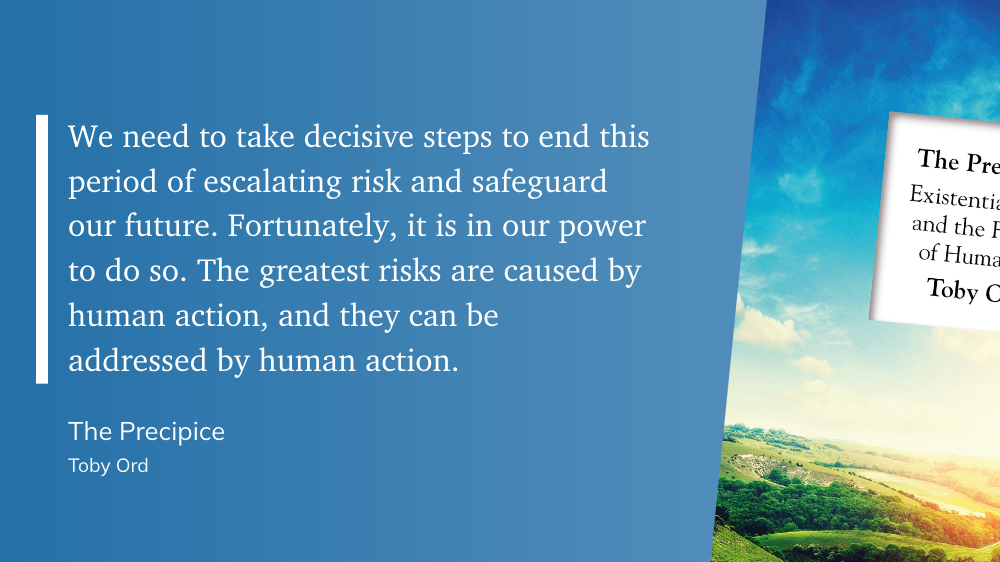In the sphere of educational research, we continually aim to find ways to deepen student learning, foster student agency, and promote equity. As we delve into this task, we encounter a range of theories and viewpoints, all of which provoke thought and prompt reevaluation of our established norms. A recent encounter with Toby Ord’s book, “The Precipice: Existential Risk and the Future of Humanity,” has stimulated such reconsideration, expanding the discourse on the role of education in navigating existential risks.
Ord’s masterstroke lies in the urgent need to address existential risks—threats that could cause our extinction or irreversibly cripple our potential. These risks include natural hazards, such as asteroids and supervolcanoes, but are mainly human-made perils, like nuclear war, climate change, and potential drawbacks of advanced AI. Our task is to translate this narrative into the context of our educational mission.
No products found.
Reimagining education involves recognizing that the stakes have never been higher. With humanity on the precipice, the school system must incorporate deeper learning, fostering an understanding of complex, real-world issues such as climate change, artificial intelligence, and geopolitical tensions. Students need to grasp the gravity of these issues, discern the links between them, and understand how their actions can contribute to solutions.
Ord’s ideas also resonate strongly with the need to enhance student agency. As we navigate this precipice, the active participation of students in their learning becomes paramount. They must be involved in problem-solving, decision-making, and value formation regarding the issues at hand. Incorporating project-based learning and collaborative problem-solving into the curriculum are ways to prepare our students to address existential risks and steer humanity away from the brink.
The theme of equity is an undercurrent in “The Precipice,” particularly when considering who suffers most from these existential risks. It’s a stark reminder that educational equity is more than just an ideal; it’s a necessity. Students from all backgrounds must have equal opportunities to understand and confront existential risks. To achieve this, we must remove barriers to high-quality education, ensure diverse representation, and empower students with the skills, knowledge, and tools to shape the future positively.
Toby Ord’s “The Precipice” is not a book about education per se, but it holds an urgent lesson for all educators. Our current education system, with its emphasis on standardized testing and rigid curriculums, falls short of preparing students for the existential risks we face. But by embracing deeper learning, promoting student agency, and ensuring educational equity, we can better prepare our students to navigate and shape their futures in this uncertain world.
To paraphrase Ord, we are the stewards of humanity’s future. It’s our responsibility to educate our students with this in mind. Let’s not shrink away from this precipice but rather use it as a springboard to leap toward a more informed, engaged, and equitable education system. It’s not just our students’ futures at stake – it’s the future of all humanity.
FAQ
Q1: What are the main themes in “The Precipice” by Toby Ord?
A1: The primary themes in “The Precipice” include existential risk, the future of humanity, artificial intelligence, climate change, nuclear war, and the responsibilities of our generation to future generations.
Q2: What does Ord mean by “existential risk”?
A2: By “existential risk,” Ord refers to potential threats that could cause human extinction or drastically hinder our ability to reach our potential. These threats could be natural (like asteroids and supervolcanoes) or human-made (such as nuclear war, advanced artificial intelligence, and climate change).
Q3: How does Ord propose we should respond to these existential risks?
A3: Ord suggests that humanity needs to recognize these risks and take coordinated, strategic action to mitigate them. He emphasizes the need for comprehensive research, international cooperation, ethical decision-making, and the prioritization of long-term sustainability over short-term gains.
Q4: How does the book relate to the concept of “student agency”?
A4: Although not directly about education, “The Precipice” can be related to student agency in the context of preparing learners to navigate, understand, and act on existential risks. It advocates for empowering students to become active participants in their learning, equipping them with the critical thinking and problem-solving skills needed to confront these global challenges.
Q5: What is the connection between the book and the concept of educational equity?
A5: The existential risks outlined in the book have unequal impacts on different populations, reflecting the broader issues of global inequality. In an educational context, this underscores the importance of providing equal opportunities for students of all backgrounds to learn about, understand, and address these risks.
Q6: How can “The Precipice” be used to inform educational practices and policies?
A6: “The Precipice” can guide educators towards integrating deeper learning about real-world issues into the curriculum. It encourages the promotion of student agency, collaborative problem-solving, and project-based learning. Moreover, it underscores the necessity of ensuring that all students, irrespective of their backgrounds, have equal access to quality education and the tools needed to shape the future positively.
The Eclectic Educator is a free resource for everyone passionate about education and creativity. If you enjoy the content and want to support the newsletter, consider becoming a paid subscriber. Your support helps keep the insights and inspiration coming!




